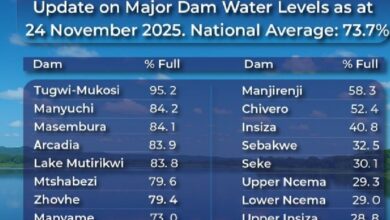Bulawayo’s dams show signs of recovery, but drought risks persist

Khumbulani Maphosa
Bulawayo, Zimbabwe – The City of Bulawayo has released its latest dam watch report, offering a glimmer of hope amid ongoing water challenges. As of Monday, February 24, 2025, the city’s operational dams are at 49.69% capacity, marking an improvement from 42.78% a year ago, according to data compiled by City officials and signed by Town Clerk C Dube.
The report highlights significant variations across the six operational dams. Mtshabezi stands at a robust 79.74%, while Insiza Mayfair and Umzingwane are at 56.29% and 48.72%, respectively.
However, critical concerns remain, particularly with Upper Ncema, which is alarmingly low at 9.26%—a level that underscores the city’s vulnerability to drought. Other dams, such as Inyankuni (19.57%) and Lower Ncema (26.18%), also reflect the uneven recovery.
Encouragingly, cumulative inflows into the dams have surged by 28.5% since the rainy season began, with a total of 196,286,786 m³ recorded as of February 24. Individual dam inflows show substantial gains: Umzingwane saw a 52.88% increase, Upper Ncema a 50.50% rise, and Mtshabezi a 28.50% boost. These inflows, driven by recent rains, have helped stabilize levels, but the overall picture remains precarious.
The report notes ongoing water management measures, including the release of water from Upper Ncema into Lower Ncema on February 12, 2025, when Lower Ncema reached a critical low of 9.26%. Despite these efforts, Bulawayo continues a 130-hour weekly water-shedding program, reflecting persistent scarcity and the looming threat of drought, particularly if rains falter.
“Drought risks are still very real,” a City of Bulawayo emphasized in a statement. “While inflows have improved, the low levels in key dams like Upper Ncema highlight the need for sustained rain and careful water management to avoid a crisis.”
The data comes as Zimbabwe grapples with the long-term effects of climate variability, including erratic rainfall patterns linked to El Niño. Last year, several dams, including Upper Ncema and Umzingwane, were decommissioned due to critically low levels, forcing stringent rationing. While the current 49.69% capacity offers some relief, experts warn that the city remains on edge, with Upper Ncema’s 9.26% capacity signaling potential trouble if dry spells return.
Community leaders and environmental groups have called for continued public awareness and government action to bolster water conservation efforts, including infrastructure upgrades and stricter enforcement of water usage policies. “We’re not out of the woods yet. This data shows progress, but Upper Ncema’s state is a wake-up call,” said Meluleki Ndlovu, a resident.
The City of Bulawayo encourages residents to stay informed via its official channels, including its website and social media, as it monitors the situation closely. The next dam watch update is anticipated next week, with hopes that sustained rainfall will further ease the pressure on the city’s water supply.





